Bunge, CoverCress, Chevron taking us into the future and into the past
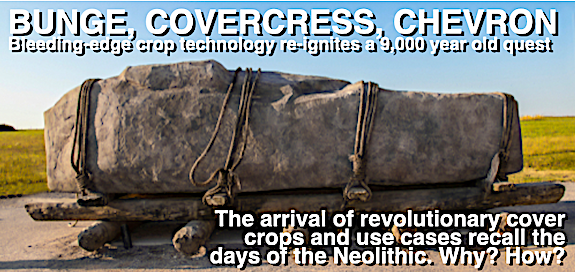
The arrival of revolutionary cover crops and use cases recall the days of the Neolithic.
When news arrived that Bunge and CoverCress signed commercial partnership to support the expansion of CCI’s CoverCress technology, a new winter oilseed crop, and that Bunge Ventures recently increased its stake in CCI through a Series C-1 round, we were suitably impressed.
Buried in the announce was the item that Chevron also acquired an ownership stake in CCI through the Series C-1 financing round that Bunge joined. That really got our attention, because Bunge and Chevron previously announced a JV to produce feedstock for renewable fuels, and many were wondering which exact direction the JV might take. Now we know a lot more.
The Bunge CCI deal
Under the commercial partnership between CCI and Bunge, CCI will supply CoverCress grain produced under contract with farmers to Bunge for processing. The strategic partnerships among Chevron, Bunge and CCI create a dedicated farm-to-fuel supply chain for the low carbon intensity oil feedstock produced from CoverCress grain.
The CoverCress backstory
CCI has converted field pennycress, a winter annual weed, into the CoverCress crop that fits into existing corn and soybean rotations. Adding a new, marketable crop into rotation on existing land during winter can provide farmers with additional revenue while also offering the ecosystem benefits of a cover crop; the CoverCress crop provides cover, decreases nitrogen losses, and improves overall soil health.
CoverCress seed allows corn and soybean farmers to add a new crop into their rotation on existing land during winter, while offering the ecosystem benefits of a cover crop, including improved soil health and carbon sequestration. It generates farm revenue as a whole grain feed ingredient, or when processed, as a low carbon intensity oil for renewable fuel production, and as a high-protein meal for animal feed.
The Bunge backstory and the St. Louis connection
The company goes back a long, long ways to its days as Bunge & Born and its origin dates to 1818, just a smidge older than the 2013-founded CoverCress. Quite a while ago, Bunge moved HQ from South America to North America, and in the early days of the pandemic moved from White Plains, NY to St. Louis, MO.
An interesting move to say the least — same backyard as Bayer Life Sciences, and a sign that St. Louis is building up a very good rivalry to Chicago as the central hub for the Midwestern bio-economy, basing around its centers of excellence in life sciences that include Washington University and the Danforth Center. The National Corn Growers Association is based there, the Clean Fuels Alliance America, a big piece of the Renewable Fuels Association. “Meet Me in St. Louis” has become a catch-cry in the advanced bioeconomy, and CoverCress is right there in St. Louis as well, along with the celebrated Yield Lab accelerator.
Looking back into the misty dawn of time
There seems to be a widely-held belief that sustainability is a recent concern and that the link between plants and transport is a new-fangled thing. That’s mostly well-intentioned bosh, sustainability is a 9,000 year old quest, an ancient art in which plants and sustainable oils have been intimately linked with transport since before the invention of the wheel. CoverCress is in some ways the proof of it, even if in its genetics CoverCress is at the bleeding edge of technology.
So, let’s look back into it.

The temple complex at Stonehenge, built in the Neolithic using transport technology developed much earlier for hunting.
Here is a picture of Stonehenge, and you’ll notice that there are some heft sarsen stones, and lately researchers have realized that they were moved there, from the Preseli Mountains in north Wales, some 300 miles. How did the ancients move that much weight, and before the wheel?
Recent research has demonstrated that the likely methodology of the ancients was a timber-based skid-rail system, greased with animal fat, with the ancients pulling great weights with rope made from twisted plant fibers, managing a walking pace of perhaps one mile per hour or even more, whereby a team could bring a stone from a great distance in one summer season. Pretty impressive stuff, and no fossil resources were harmed during the building of this monument.
But the technology wasn’t invented for Stonehenge, or any ‘henge, or temple or anything like it. Researchers have found it was invented for large-scale community hunting.
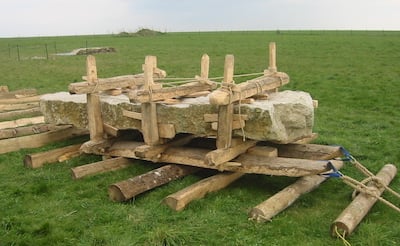
A modern re-creation of a timber sledge. The bottom timbers could be used as rollers, or as rails in the manner of a railway track.
Seems that our Paleolithic predecessors were not grunting, solitary, ignorant and half-frozen bands of sojourning nomads, after all. Rather, they sang, drew complex art, they organized in large numbers and worshipped in a religion focused on the themes of death and re-birth.
They learned to liquidate herds of Persian gazelles via the use of desert kite technology, a herding and killing enclosure that required the moving of roughly 100 tons of stone, and thereafter as many as seven tons of meat, fats and bones had to be moved to a processing site.
In days without refrigerated trucks or wheels, time was of the essence and greased sledges did the work. They were fervent technologists.
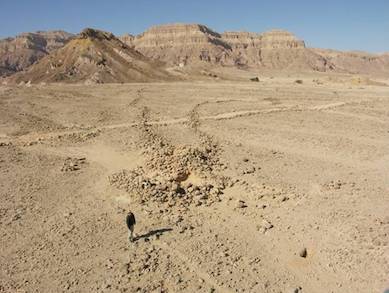
A desert kite in the Samar Desert, a narrowing rock enclosure into which game was driven to facilitate the kill.
Researchers have also found that the grease and oils from roasting animals was carefully saved. Their most valuable technology, pottery, was dedicated in part to the saving of oils, and not just water or wine. Natural oils and grease were valued for transport applications even before the wheel. before wheels were, and for transport, and the ancients went to a lot of trouble to save them. There’s been a prejudice that the history of sustainable oils was a case of food first, transport second, but the historical record doesn’t support that.
Plant oils came later. Having tapped animal fats, they learned to exploit the olive trees that originated and still grow wild in south Asia Minor, not far from where the hunting temples were and where mankind first domesticated wheat.
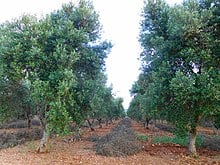
Olive trees were the first source of renewable oils.
Grain processing is the technology that showed the scale and complexity of Paleolithic and early Neolithic hunting. At the temples complex of Gobekli Tepe, dating back to the 9th millennium BCE, researchers have found more than seven hundred implements for food processing — grinders, slabs, hand-stones, mortars, and pestles.
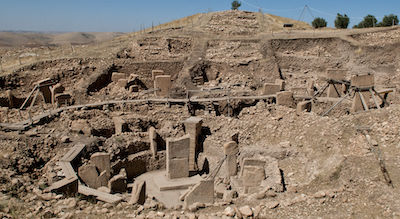
The 9000 year old temple complex at Gobekli Tepe pre-dates the Neolithic revolution — yet, the first domesticated wheat strains are found in the wild just 20 miles away.
Our hunter-gatherers were coming together in great numbers for major feasts, and we surmise from the iconography and bones of the site that they arrived for midsummer rituals that are likely to have reflected their religion centered around a cycle of death and re-birth. There’s sustainability, again, in their primitive religion.
Crops, oils, transport — linked since the beginning
Yet, we also might look at the origins of cover crops, too. For, what is a cover crop, if it is not something which is cultivated in a field to provide protection for the main show, like a gate that keeps a stadium from being vandalized between games? It preserves, and perhaps contributes toward yield via the addition of nutrients — certainly, though, conservation is at the heart of it, and to sustain is to conserve.
Conservation of what, in all? Soil health, in the end. Farmers get a bad rap for lack of commitment to healthy farms and sustainable farming practices; in my experience, far from deserved. Sometimes I believe that an honest discussion — about the balancing of the long-term goals of soil health and biodiversity against the short-term goals of product yield and income — becomes reduced by partisans into demonization of the parties to the debate.
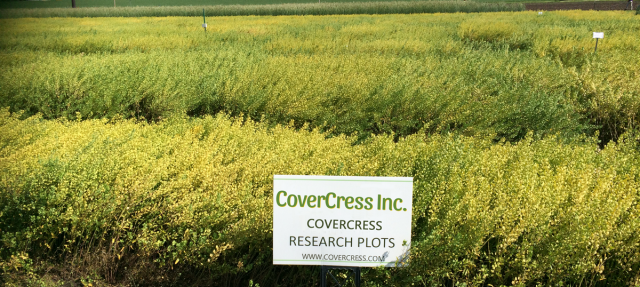 Cover crops offer us a way out of our dilemma, because in this case less can be more. Less land can produce more income. More income for the grower means higher land prices, and that is the most effective deterrent for land use conversion, a goal of the environmental movement. Growers do not buy the field next door when land is expensive, they buy land when it is cheap.
Cover crops offer us a way out of our dilemma, because in this case less can be more. Less land can produce more income. More income for the grower means higher land prices, and that is the most effective deterrent for land use conversion, a goal of the environmental movement. Growers do not buy the field next door when land is expensive, they buy land when it is cheap.
Higher land prices, and crop prices, generally lead to land use intensification, not expanded acreage. Evidence for this? Consider that the United States is producing three times more corn and using fewer acres, than 100 years ago.
That’s a model we could benefit from in the production of sustainable oils, too. It takes new acreage to plant new trees and harvest tree oils, it takes slaughter to increase the availability of animal fats and oils. But here is CoverCress — a technology that simply re-uses the same land.
Re-use, it’s a word we don’t hear enough about in the sustainability movement. We hear a lot about “reduce” and “recycle”. Re-use seems to get short shrift. People are very excited about capturing and storing CO2, for example, after its first use. But what will we use it for? That seems to be less interesting and engages fewer minds.
Use. It may be the most characteristic human word. Where does the word come from, anyway? You won’t be surprised to learn it is very, very old. It has been reconstructed as *h₃eyt, in the mother language of Indo-European. It meant, simply, to fetch something. So, you see, the concept of use is bundled up in the idea of transport.

A Bashkir woman, descendants of the Yamyana people that still live near the steppe
They are known, the people of that place and time, as the Yamnaya. They lived on the Caucasus steppe, on the north side of the Black Sea, including much of the Crimea, the very land that Russia is trying to snatch from Ukraine. Amongst their goods have been found the oldest wheels in the world dedicated to transport. There we go again, movement. Out story is filled with it today.
Why did they turn to agriculture? Why, indeed, are we doing so again? Is there a link?
The hunter-gatherers didn’t do it for their health, in the obvious sense of the term. Humans were bigger and healthier before the Neolithic Revolution than for thousands of years after it, we know that from skeletons that have been found. Lifespans decreased with the shift from hunting and gathering, we know that too.
Why do it?
The answer is rooted in sustainability. The individuals were, most of the time, better off in the pre-Neolithic. Yet, they were more subject to the vagaries of weather and cycles of cold and drought. Winter disaster befell them swiftly, even after happy summers lived high off the hog.
Survival for the long-term was the issue. With agriculture, communities became larger and cultures lasted longer. With agriculture came higher yields, more calories to share, the land reached its human carrying capacity and the migrations began. The Yamnaya turned the wheel on its side and sweeping migrations into Europe, Persia and India began.
They became us. Their words mehter, phater, brehter, swesor became our mother, father, brother, sister. We have conserved their culture without realizing it, we have made it sustainable. We have conserved their intellectual property and we continue to use it today. We took their seeds, wheels, control of fire, cooking, sewing, rafts, sails, rope, horses, dogs, and knives, and based our civilization around them. We took the lubricating oils that reduce resistance and make wheels — or timber sledges — more efficient, and we use them still today. What bike or car would travel without axle lubricant?
You might think that in their migrations they changed the physical world through land use conversion, not always for the better, and you would be right. They slayed vast forests, made deserts, drove animals to extinction and spread disease. But that is population pressure, not price pressure. Price pressure makes us more intensive, not more expansive. Now, with technologies like CoverCress we have a better way to intensify. It is not just a case of planting more plants per square foot and using more fertilizer and more technology to make the plants stand straighter and tolerate the crowded conditions.
You see, CoverCress has given us a new way to solve the old problem. Now, we can use the fallow season to intensify our agriculture and grow two crops where one was grown before, and different crops that interact in different ways with the soil. We are using time instead of space.
Happily, this new solution to the old problem also provides the old materials that enabled transport — lubricant and energy — in a new way, through a new production crop based on an old Brassica plant, pennycress. Really, there’s a lot to look forward to with this one — and also, as we have seen in these paragraphs, much to look back on with pleasure.
A cautionary note
One reader writes: “CoverCress, like all in the mustard family, are not not symbiotic or mutualistic with soil fungi. Part of the idea about cover crops is to provide living material during the winter to promote a thriving fungi component of the soil microbe community. As in my aborted presentation for you, fungi are much more carbon efficient than bacteria and do not produce nitrous oxide GHG in the carbon/nitrogen cycle.” But our friend offers hope: “Similar to Pivot Bio’s nitrogen fixing bacteria for grains crops, I would think that the non-mutualistic aspect of CoverCress could be addressed by gene engineering. That would make a near perfect cover crop. I hope somebody can address this.” A concern for the near-term? Probably not. But a valuable insight for the long-term. What do you think?
Reaction from the stakeholders
“Bunge is pleased to expand our relationship with CCI to continue to develop next generation lower carbon feedstocks, which will also help meet the growing demand for renewable fuels. We believe rotational cover crops will play a key role in our strategy in connection with the recently announced partnership with Chevron. Together, we share a commitment to sustainability and reducing carbon in our value chains,” said Greg Heckman, Bunge CEO.
“Chevron continues its efforts to build a leading renewable fuels business by investing in all parts of the value chain,” said Mark Nelson, executive vice president of Downstream and Chemicals for Chevron. “This investment in CCI advances our efforts to secure a diversified source of lower carbon intensity, reliable feedstocks for our forthcoming joint venture with Bunge.”
“The advancements in the development and performance of our climate-smart agricultural product we have branded as CoverCress™, coupled with the expansion of our strategic partnerships with Bunge and Chevron, will accelerate the pace of our commercialization efforts with growers as well the value proposition of our company”, said Mike DeCamp, CCI’s CEO. “Farmers are the key to enabling our CoverCress technology to make a difference to lowering the carbon intensity of diesel and jet fuel. That is why this agreement is so critical—it enables us and our farmer partners to earn more from the distinctive aspect of our ultra-low carbon grain than just a commodity value.”
Category: Top Stories















